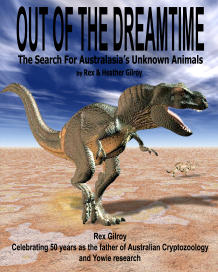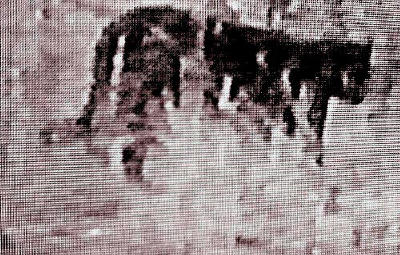
Lithgow Cat Still From Original Footage-Taken From The Pounds TV © Greg 2001This photo, taken from the video footage of Mr and Mrs Wayne and Gail Pound, shows a large black cat-like animal, as it frolicked with a small feral cat in grass, in the backyard of their Lithgow home.
The photo was taken from the video image by Greg Foster and has been slightly enhanced by him after studying the indistinct image of the animal standing in tall grass.
© Greg 2001
Read Excerpts From
Out Of The Dreamtime -
The Search for Australasia’s Unknown Animals
by Rex & Heather Gilroy
Copyright
© Rex Gilroy 2006
No part of this publication including all photographs and illustrations may be reproduced or transmitted in any form or by any means, electronic or mechanical, including photocopying, recording or any information storage and retrieval system now known or to be invented, without permission in writing from the publisher, except by a reviewer who wishes to quote brief passages in connection with a review, written for inclusion in a magazine, newspaper or broadcast.
Dedication
This book is affectionately dedicated to my loyal, supportive and dedicated wife, and Number One researcher and fieldworker, Heather. This book is also affectionately dedicated to my late father W.F. [Bill] Gilroy [1904-1996], whose tales of his native Scotland and the Loch Ness Monster, led me, from about the age of five [!] to my lifelong research of the natural sciences and the fields of Cryptozoology and relict hominology, which has resulted in this book.
PART THREE
LIONS AND TIGERS OF THE
AUSTRALIAN BUSHLAND
__________
CHAPTER NINE
The “Australian Panther” – Big Cats of the Bushland
They have been reported seen in every Australian state: often huge, black-furred cat-like animals that prowl the more remote regions of our vast mountain ranges, from where they emerge to terrorise scattered farming communities, killing livestock and leaving behind their large paw-prints as calling cards.
They are the mysterious “Australian Panthers”, creatures around which as much folklore as that accorded to the marsupial lions and Thylacine has been spun. They are just as real to the people of the bush as any of the above, and will continue to exercise a hold on the imagination of Australians for generations to come.
The “Australian Panther” had been known to our Aboriginal people for untold thousands of years before the coming of European settlement, and therefore, like all our other mystery ‘monsters’, it has inhabited this continent since Ice-Age times. Much popular myth surrounds these animals, the most common being that they are escaped circus or zoo panthers that have gone wild.
There is hardly a remote country town without its own version of that old folktale that “many years ago a circus was passing through the town, and a truck carrying a cage with two or more Asian panthers overturned and the animals escaped into the wild and have bred up”. None of these folktales have ever been substantiated.
Nor can another popular legend that began in the years following the end of World War Two; which suggests they are the offspring of regimental mascots, released into the wild by American servicemen. The “regimental mascot” explanation is easily dismissed, as the American armed forces did not keep them here during WW11.
The “Australian Panther”, like so many other mystery creatures investigated in this book, has so far evaded capture; and until one is available for scientific study, its actual identity, like that of the ‘lions’ of the previous chapter, will continue to remain unestablished, and unrecognised by scientists.
For reasons to follow, the ‘panther’ can only be a marsupial and a carnivore. Therefore there remains only the problem of its actual place in the marsupial family. I personally believe that, when eventually one of these creatures is available for study, it will be found to belong either with, or a close relative of, the Marsupial Lions.
The Australian Miocene-Pliocene-Pleistocene fossil records have lately revealed a wide range of hitherto unknown marsupial species, particularly the marsupial lions. If the fossil remains of an animal fitting the general physical description of the ‘panther’ has not been uncovered at the time of writing this book, then I believe its discovery is inevitable.
The number of case-histories of ‘Australian Panther’ sightings is voluminous and far too extensive to be adequately covered in this chapter, although the reports to follow, selected from every Australian state, should give the reader plenty of food for thought on this mystery.
We begin our search in Tasmania, the island state mostly associated with the ‘extinct’ Thylacine; and yet this island has its own ‘panther’ traditions. Prior to the flooding of the Bass Strait land-bridge toward the close of the last great ice-age about 12,000 years ago, no natural barrier existed to prevent these animals from entering Tasmania, and it is evident that today, isolated from their mainland counterparts, a good many of these marsupial carnivores continue to survive there.Tom Forester, a camper, was with two mates exploring the Snowy Range west of Hobart one weekend in January 1972. On this particular Sunday morning they all spotted a large, black-furred cat-like animal observing them from the edge of dense scrub nearby their camp. They had no sooner got to their feet than the creature turned to vanish quickly into the trees.
The men later found large paw prints embedded in soil near their camp, suggesting the animal had been there the previous night. Later that afternoon Tom went to get water from a creek. As he crouched on the creeks’ edge beneath a tall boulder, he saw a dark shadow reflected in the water. Before he could turn to look up, he was thrown aside as the dark shape leapt upon him with a screech, and then bounded across the creek into bushland. A shocked, badly scratched Tom staggered back to camp. Soon afterward his startled friends went in search of the mystery animal, but it had left the area.
In April 1989 a group of a dozen people saw a black-furred panther-like animal, about two metres in length from head to tail, and standing up to 0.6 of a metre on all fours, as it moved along the shore of Lake Gordon in the Mt Wright area, north of the Snowy Range.
An animal of this size and description was claimed seen bounding across the Marlborough Highway one afternoon in February 1990. Ten years earlier, one eyewitness claimed to have seen no less than three of these large ‘panthers’ roaming together near Split Rock, west of Great Lake. This report resulted in one farmer from the Mt Arthur district east of Launceston relating how, one day in 1960, he had watched powerlessly as a “black cat-like monster”, a good seven feet [2.3m] from head to tail, bounded out of scrub onto his property to attack and carry off a large calf.
Craig Black, a young fossicker, was digging in a creek in Ben Lomond National Park one day in 1961, when he realised he was being watched by a large black ‘panther’ from among bushes, further up the creek on the opposite bank. The animal emerged, then dashed across the shallow creek. It was apparently a female. “I am positive I saw that it was carrying a pouched cub,” he said later to a ranger.
A Mr Gregory Hunter, his wife and another couple, were driving near Smithton in the north-west of the state one March day in 1968, when they drove past a 1.6m long black-furred “giant cat” standing on the scrubby roadside.
“We stopped. I backed up the car hoping we could get a better look, but the strange beast had vanished,” he said.The Cradle Mountain-Lake St Clair region has long been the scene of ‘panther’ sightings stretching back to the 19th century. In 1970, the region was alive with sightings reports of animals that left paw prints up to 12.6cm in width.
At Mt Olympus, for example, campers discovered massive tracks embedded in mud near their camp, and, at the southern end of the lake, bushwalkers were horrified to discover a dismembered cow, torn apart only a day or two before by a creature whose paw prints were still visible in the soil about the site.
The author frequently receives such tales from widely-scattered and remote regions of Australia, and many of these reports often concern the loud, weird, screeching sounds made by these animals.
In 1928, in the Great Western Tiers, south-west of Launceston, a group of roadworkers were terrified in their camp one night, by the incessant howling and screaming sounds of two or three unseen creatures. The men were convinced the area was inhabited by “jungle cats”, and refused to stay there another night!
In 1940 outside Strathgordon, west of Lake Gordon in the wild bush country of south-western Tasmania, a farmer and his wife spotted a “seven-foot-length, giant, panther-like animal” [2.13m], as it dashed across their back paddock, and leapt effortlessly over a six foot [1.83m] fence before disappearing into trees.
We turn now to VictoriaOn the morning of 29th January 1976, at Lake Merrimu near Bacchus Marsh west of Melbourne, a farmer and his family claimed to have seen a “six foot [1.83m] length, two foot [61cm] tall, black-furred cat-like monster”, as it moved across their property, dragging a dead calf in its powerful jaws. They stood dumbfounded for a moment before the farmer raced into the house to grab a rifle. The animal and its ‘kill’ had by now vanished into scrub, but the man and his teenage son gave chase. The strange beast, however, eluded them in the dense bushland.
East of Melbourne, near Hastings in 1977, a farmer, Mr Todd Anderson, lost three pigs in the space of a week, to a mysterious animal that visited his property at night. Each time it carried off a pig, the creature left behind enormous claw and pad marks in the farmyard soil.
In fact, the “Hastings Monster” has been known for generations to the locals. East of Hastings, across country in the Warragul-Moe districts, this ‘monster’ continues to make its presence known. In 1990, two motorcyclists claim to have been confronted by a “seven foot length [2.13m] head-to-tail, black-furred, panther-like creature”, on a bush tack half way between Warragul and Drouin.
In 1999, there were several sightings of a sleek, black-furred, panther-like animal, or animals, in the Moe district. Late one night in March that year, a motorist, John Clark, had to apply the brakes when a large ‘panther’ appeared ahead of his vehicle in the headlights, standing on a lonely bush road. It was dazzled by the headlights glare momentarily, before dashing off the road into the darkness.
During 2000 there were reports of fresh tracks of the “Moe Monster” found on properties about the district. Back in September 1978 a long ‘trackway’ of 15.3cm length paw prints were found on a muddy bush track close to the town. Eleven years later these animals were still being seen thereabouts, for in November 1989, a 1.6m long ‘panther’ was claimed seen crossing a paddock late one afternoon.
In June 1991, I received a report that several pigs and two calves had been killed by a mysterious animal in the vicinity of Yarragon. A farmer, a Mr Davis, discovered his missing animals in a heap in bushland, about two kilometres from his home. All had been mutilated and eaten and all had fang marks behind their heads - a characteristic of ‘panther’ kills.
Main Book Index | Mysterious Australia Homepage | URU Homepage | Australian Yowie Research Centre
